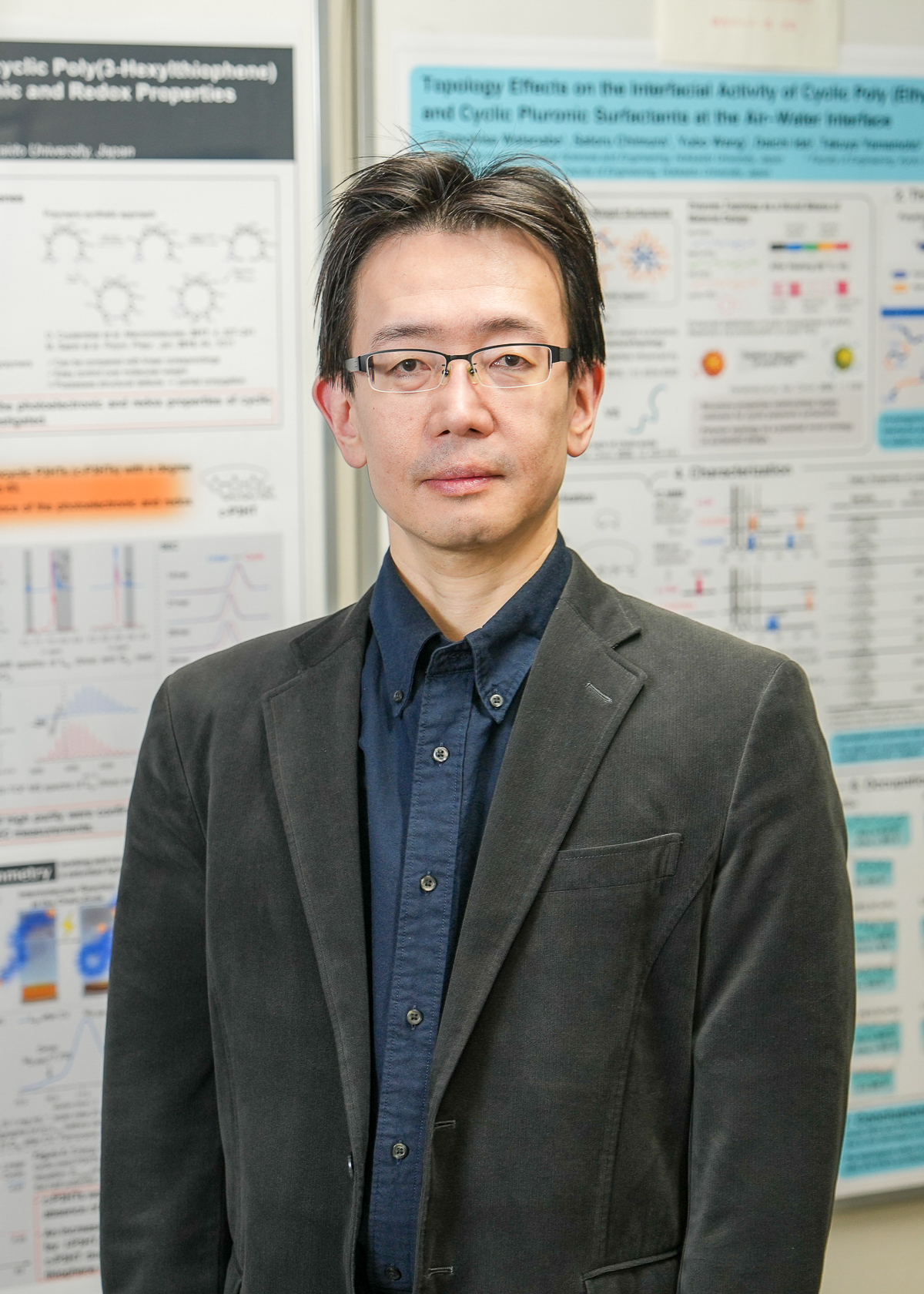PI Shin-ichiro Sato Associate Professor
PI message
Remarkable progress in synthetic technique in recent years has made it possible to prepare monocyclic and multicyclic polymers with a variety of chemical structures. Extensive researches are conducted accordingly, and much knowledge is obtained regarding the unique properties and functions of polymeric materials based on their topology and the properties of cyclic polymers in the composite state. In our research group, characteristic properties and functions of cyclic polymers, which cannot be realized by linear or branched polymers, are pursued as one of the representative research themes. In particular, we focus on the unconventional topology effects of cyclic polymers on nanoparticle composites and their responsiveness to explore their potential as novel functional materials.
PI Takuya Yamamoto Associate Professor
Research
We pursue the special functions that can be expressed by combining computational chemistry and polymer synthesis. Novel materials with molecular recognition functions, optical functions, electrical conductivity, and biocompatibility are developed by computationally optimized molecular designs and polymer synthesis. In particular, we recently developed a novel technique for dispersion stabilization of nanoparticles by physisorption using cyclic polyethylene glycol (PEG). The results show that cyclic PEG significantly improves the dispersion stability of gold nanoparticles against various environments, such as freezing, lyophilization, heating, and physiological conditions, compared to linear PEG. Interestingly, the dispersion stabilizing effect of cyclic PEG even exceeded that of commonly used thiolated PEG. This is an introduction of the “shape” (topology) of polymers into material design, which will establish a broad interdisciplinary field of polymer chemistry, materials science, computational chemistry, and pharmaceutical sciences, and will have a propagation effect on technology and industry. Currently, we are conducting research to elucidate the physisorption mechanisms of cyclic PEG and to further enhance its functionality.
Member
-
Shin-ichiro SatoAssociate Professor
-
Takuya YamamotoAssociate Professor
Main Research Achievements
- Oziri, O. J.; Maeki, M., Tokeshi, M.; Isono, T.; Tajima, K.; Satoh, T.; Sato, S.; *Yamamoto, T. Langmuir 2021, 37, in press.
DOI: 10.1021/acs.langmuir.1c03027 - *Yamamoto, T.; Masuda, Y.; Tezuka, Y.; Korchagina, E.; *Winnik, F. M. Langmuir 2022, 38, in press.
DOI: 10.1021/acs.langmuir.0c03358 - Oziri, O. J.; Wang, Y.; Watanabe, T.; Uno, S.; Maeki, M.; Tokeshi, M.; Isono, T.; Tajima, K.; Satoh, T.; Sato, S.; Miura, Y.; *Yamamoto, T. Nanoscale Adv. 2022, 4, 532–545.
DOI: 10.1039/D1NA00720C - Watanabe, T.; Chimura, S.; Wang, Y.; Ono, T.; Isono, T.; Tajima, K.; Satoh, T.; Sato, S.; Ida, D.; *Yamamoto, T. Langmuir 2021, 37, 6974–6984.
DOI: 10.1021/acs.langmuir.1c00513 - Wang, Y.; Quinsaat, J. E. Q.; Ono, T.; Maeki, M.; Tokeshi, M.; Isono, T.; Tajima, K.; Satoh, T.; Sato, S.; Miura, Y.; *Yamamoto, T. Nat. Commun. 2020, 11, 6089.
DOI: 10.1038/s41467-020-19947-8 - *Yamamoto, T.; Hosokawa, M.; Nakamura, M.; Sato, S.; Isono, T.; Tajima, K.; Satoh, T.; Sato, M.; Tezuka, Y.; Saeki, A.; Kikkawa, Y. Macromolecules, 2018, 51, 9284–9293.
DOI: 10.1021/acs.macromol.8b01681 - *Yamamoto, T.; Inoue, K.; Tezuka, Y. Polym. J. 2016, 48, 391–398.
DOI: 10.1038/pj.2015.134 - *Yamamoto, T.; Yagyu, S.; Tezuka, Y. J. Am. Chem. Soc. 2016, 138, 3904−3911.
DOI: 10.1021/jacs.6b00800 - Xiong, K.; Mitimo, H.; Su, X.; Shi, Y.; Sato, S.-I,; Ijiro, T. Nanoscale Advances, 2021, 13, 3762-3769.
DOI: 10.1039/D1NA00187F - Nomura, S.; Sato, S.-I, Erata, T. Chem. Phys. Lett., 2020, 742, 137154.
DOI: 10.1016/j.cplett.2020.137154
Contact
Shin-ichiro Sato
s-sato(at)eng.hokudai.ac.jp
Takuya Yamamoto
yamamoto.t(at)eng.hokudai.ac.jp



